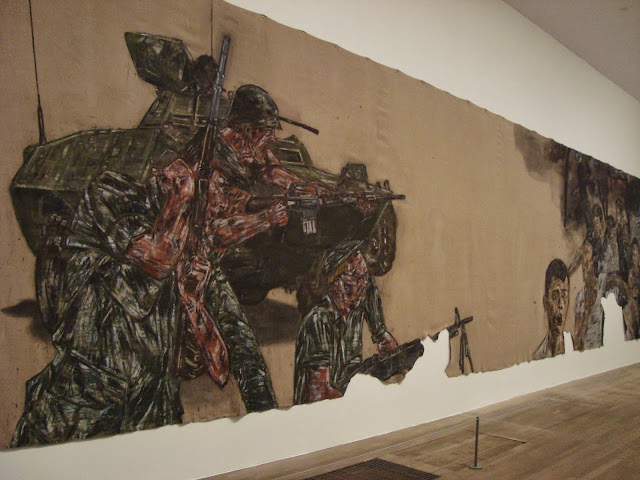The Tate
Modern is holding an intriguing and fascinating exhibition called
'Transformed Visions Facing History' (located on Level 3, room 9)
that present both Leon Golub and Hrair Sarkissian's artworks that
bring together two bodies of work that confront violence and
atrocities of contemporary war and civil society. This major
exhibition gives a first opportunity in London to explore their
responses to the theme of violence and also a glimpse of each artist
respectively.
Celebrating 25 years of the Tate Americas Foundations' endowment, courtesy of Ulrich and Harriet Meyer.
'Vietnam
II' (1973) by Leon Golub illustrates the confrontation of immoral
destructiveness of violence, Leon Golub was an American painter that
also received considerable attention through exhibiting other
paintings of his period during enlisting in the US Army. - (Bryant, 2013, http://www.tate.org.uk) Vietnam II
has been done by acrylic on linen (over three metres high and more
than twelve metres long) which visually show a huge impact on him
reflected by the ambitious decision to work on such a huge scale. The
rough brush strokes give a strong and unsettling movement to the
painting which purposely show a significant meaning behind the
harshness of the Vietnam War, the white and black assets used is very
contrasting and so it's very bold and brings the imagery of the
struggle and obstacles both American soldiers and the Vietnamese
community face.
‘Unlike traditional history painting, in which the historical referent frames and conditions the viewer’s understanding, Golub’s historical project is closer to that of Goya ... whose political “message” problematizes historical responsibility’ - Jon Bird (Bird, p.57). Francisco de Goya (1746-1828) - (Taylor, 2004, http://www.tate.org.uk)
'Execution
Squares' by Hrair Sarkissian is a series of photographs of three
Syrian cities – Aleppo, Lattakia and Damascus. - (Sarkissian, 2008, http://www.hrairsarkissian.com) Taken in the early
morning hours (the time the executions usually take place) the
deserted images reveal a fragile paradox that exists between the
beauty and constancy of the physical urban environment and the
political and social realities that they experience. Sarkissian
demonstrates the aftermath of each city with a clear and consistent
format similarly to all eight photographs with the same palette of
colour and composition which shows the depth of space he is in.
It
was very interesting to view two different mediums that therefore
portray in many levels of feelings, both physically and
psychologically. The way I felt sympathy towards both artworks, by
the sunrise highlighting the architecture and the lifeless city from
Sarikissian's photographs, such powerful imagery that speaks for
itself. I felt very empty by visualising myself in that enivonment
Golub's work gave such a powerful impact to me by the expression of
the afraid and haunted Vietnamese people, it makes viewers imagine
such a life changing and horrible experience. This is a strong exhibition that will automatically draw the viewers in due to the large scale and reflects the past that we only read about and never experience.
- Tate Modern 30/09/13
- Bryant, Edward. (2013) Leon Golub: Artist Biography. [online] London. Tate. Available at (http://www.tate.org.uk/art/artists/leon-golub-2207) (Accessed 30/09/13))
- Taylor, Rachel. (2004) Vietnam II Summary. [online] London. Tate. Available at (http://www.tate.org.uk/art/artworks/golub-vietnam-ii-t13702/text-summary) (Accessed 30/09/13)
- Sarkissian, Hrair. (2008) Execution Squares. [online] Available at (http://www.hrairsarkissian.com/Portfolio/Pages/Execution_Squares.html) (Accessed 30/09/13)








I really liked your review of 'Vietnam ll' the cultural and historical links you talked about made it stand out as a more important piece.
ReplyDelete